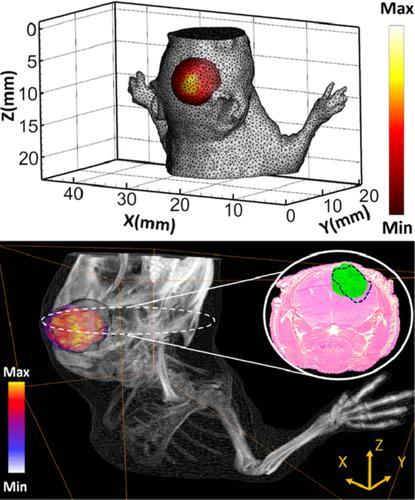当前位置:
X-MOL 学术
›
J. Biophotonics
›
论文详情
Our official English website, www.x-mol.net, welcomes your feedback! (Note: you will need to create a separate account there.)
Sparse-graph manifold learning method for bioluminescence tomography.
Journal of Biophotonics ( IF 2.8 ) Pub Date : 2020-02-09 , DOI: 10.1002/jbio.201960218 Hongbo Guo 1, 2, 3 , Ling Gao 1, 3, 4 , Jingjing Yu 5 , Xiaowei He 1, 2 , Hai Wang 1, 3 , Jie Zheng 1, 3 , Xudong Yang 1, 3
Journal of Biophotonics ( IF 2.8 ) Pub Date : 2020-02-09 , DOI: 10.1002/jbio.201960218 Hongbo Guo 1, 2, 3 , Ling Gao 1, 3, 4 , Jingjing Yu 5 , Xiaowei He 1, 2 , Hai Wang 1, 3 , Jie Zheng 1, 3 , Xudong Yang 1, 3
Affiliation

|
In preclinical researches, bioluminescence tomography (BLT) has widely been used for tumor imaging and monitoring, imaged‐guided tumor therapy, and so forth. For these biological applications, both tumor spatial location and morphology analysis are the leading problems needed to be taken into account. However, most existing BLT reconstruction methods were proposed for some specific applications with a focus on sparse representation or morphology recovery, respectively. How to design a versatile algorithm that can simultaneously deal with both aspects remains an impending problem. In this study, a Sparse‐Graph Manifold Learning (SGML) method was proposed to balance the source sparseness and morphology, by integrating non‐convex sparsity constraint and dynamic Laplacian graph model. Furthermore, based on the nonconvex optimization theory and some iterative approximation, we proposed a novel iteratively reweighted soft thresholding algorithm (IRSTA) to solve the SGML model. Numerical simulations and in vivo experiments result demonstrated that the proposed SGML method performed much superior to the comparative methods in spatial localization and tumor morphology recovery for various source settings. It is believed that the SGML method can be applied to the related optical tomography and facilitate the development of optical molecular tomography.
中文翻译:

生物发光层析成像的稀疏图流形学习方法。
在临床前研究中,生物发光层析成像(BLT)已广泛用于肿瘤成像和监测,成像引导的肿瘤治疗等。对于这些生物学应用,肿瘤空间位置和形态分析都是需要考虑的主要问题。但是,大多数现有的BLT重建方法是针对某些特定应用提出的,分别针对稀疏表示或形态恢复。如何设计一种可以同时处理两个方面的通用算法仍然是一个迫在眉睫的问题。在这项研究中,提出了一种稀疏图流形学习(SGML)方法,通过整合非凸稀疏约束和动态拉普拉斯图模型来平衡源稀疏性和形态。此外,基于非凸优化理论和一些迭代逼近,我们提出了一种新颖的迭代加权软阈值算法(IRSTA)来求解SGML模型。数值模拟和体内实验结果表明,所提出的SGML方法在各种源设置的空间定位和肿瘤形态恢复方面均优于比较方法。相信SGML方法可以应用于相关的光学层析成像并且促进光学分子层析成像的发展。数值模拟和体内实验结果表明,所提出的SGML方法在各种源设置的空间定位和肿瘤形态恢复方面均优于比较方法。相信SGML方法可以应用于相关的光学层析成像并且促进光学分子层析成像的发展。数值模拟和体内实验结果表明,所提出的SGML方法在各种源设置的空间定位和肿瘤形态恢复方面均优于比较方法。相信SGML方法可以应用于相关的光学层析成像并且促进光学分子层析成像的发展。
更新日期:2020-02-09

中文翻译:

生物发光层析成像的稀疏图流形学习方法。
在临床前研究中,生物发光层析成像(BLT)已广泛用于肿瘤成像和监测,成像引导的肿瘤治疗等。对于这些生物学应用,肿瘤空间位置和形态分析都是需要考虑的主要问题。但是,大多数现有的BLT重建方法是针对某些特定应用提出的,分别针对稀疏表示或形态恢复。如何设计一种可以同时处理两个方面的通用算法仍然是一个迫在眉睫的问题。在这项研究中,提出了一种稀疏图流形学习(SGML)方法,通过整合非凸稀疏约束和动态拉普拉斯图模型来平衡源稀疏性和形态。此外,基于非凸优化理论和一些迭代逼近,我们提出了一种新颖的迭代加权软阈值算法(IRSTA)来求解SGML模型。数值模拟和体内实验结果表明,所提出的SGML方法在各种源设置的空间定位和肿瘤形态恢复方面均优于比较方法。相信SGML方法可以应用于相关的光学层析成像并且促进光学分子层析成像的发展。数值模拟和体内实验结果表明,所提出的SGML方法在各种源设置的空间定位和肿瘤形态恢复方面均优于比较方法。相信SGML方法可以应用于相关的光学层析成像并且促进光学分子层析成像的发展。数值模拟和体内实验结果表明,所提出的SGML方法在各种源设置的空间定位和肿瘤形态恢复方面均优于比较方法。相信SGML方法可以应用于相关的光学层析成像并且促进光学分子层析成像的发展。



























 京公网安备 11010802027423号
京公网安备 11010802027423号